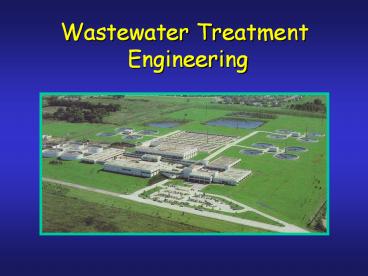Wastewater Treatment - PowerPoint PPT Presentation
Title:
Wastewater Treatment
Description:
Hydraulic structures. CE5508: Biogeochem., CE5504: Surf.Water ... CE5501 - Environmental Process Engineering. CE5502 - Biological Waste Treatment Processes ... – PowerPoint PPT presentation
Number of Views:35067
Avg rating:3.0/5.0
Title: Wastewater Treatment
1
Wastewater Treatment Engineering
2
Environ. Engineering Course Sequence
Thermo
CE3501
Fluids
P-Chem
CE3502
CE3620 Water Resources
CE4501 Env.Chem
CE4506 Regs,P2,3
CE4504 Air Quality
GE3850 Geohydrol.
CE4508, 4507,4509 Drinking WasteWater
ce4505 Surf.Water
CE4630 Hydraulic structures
BL4451 Limnology
FW4220 Wetlands
CE4620 Open Channel Flow
CE5508 Biogeochem., CE5504 Surf.Water Qual.
Modeling
3
Historical Background
Public Health
Environmental Protection
A 1920s, study of the East and Fox Rivers in
Green Bay was commissioned because workers in
downtown could not open windows in summer due to
the stench. Environmental problems plague this
system to this day.
Investigation of an outbreak of cholera in London
in 1854 provided one of the first links between
sewage disposal, drinking water supply and
waterborne disease.
4
Nature of Wastewater
- Whats in wastewater?
- human feces and urine
- food from sinks
- soaps and other cleaning agents
- runoff from streets and lawns
- industrial discharges
5
Nature of Wastewater
- and water lots of it!
- Urinal - 1 gallon per flush 0.4 gal/flush
- Toilet - 4 gallons per flush 2 gal/flush
- Shower - 20 gallons per use
- Overall - 55 gal/person/day
6
So whats the problem?
Nature of Wastewater
7
Levels of Treatment
8
Regulatory Basis
9
Scope of Application
On-Site
Urban - Municipal
Rural - Municipal
Industrial
10
Portage Lake Wastewater Treatment Plant
RAS
2 Clarifier
1 Clarifier
Fe added
Flow Equalization
UV Disinfection
Fe added
Aeration Tank
2 Clarifier
1 Clarifier
RAS
Grit Chamber
WAS
Recycle
Bar Screens
1st Stage Anaerobic Digester
2nd Stage Anaerobic Digester
1S
Supernatant
Polymer Added
Land Application
Sludge Storage
Filter Press
Lift Station
11
Wastewater Treatment (Preliminary)
Bar Racks and Screens
Bar racks and screens remove large solids which
could clog pumps and pipes in the wastewater
treatment plant. Solids are collected and sent
to a landfill.
12
Wastewater Treatment (Primary)
Settling Tank
Settling tanks remove the large solids which
remain suspended in the wastewater and about 50
of the oxygen-demanding substances. The solids
are sent on for further treatment (sludge
digestion) and ultimate disposal.
13
Wastewater Treatment (Secondary)
Activated Sludge
In the activated sludge process, bacteria and
other microorganisms are used to remove small
solids and oxygen-demanding substances present in
the wastewater. Outflow from this tank undergoes
settling and the excess sludge is sent on for
further treatment (sludge digestion) and ultimate
disposal.
14
Wastewater Treatment (Tertiary)
Tertiary treatment refers to any of a variety of
biological, chemical, and/or physical methods
used to reduce levels of specific pollutants in a
wastewater stream. Among these are levels of
solids and oxygen-demanding materials, toxic
metals and organic chemicals, and algal nutrients
such as nitrogen and phosphorus. All wastewater
treatment plants (gt2 MGD) discharging to the
Great Lake are required to remove phosphorus.
This is often accomplished through chemical
precipitation as described below.
Phosphorus removal by precipitation Ferric
chloride, Fe(Cl)3 producing FePO4 and
Fe(OH)3 Alum, Al2(SO4)318H2O producing AlPO4
and Al(OH)3
15
Wastewater Treatment (Tertiary)
Carbon adsorption
Carbon adsorption is an incredibly effective
means of removing organic chemicals from
wastewater chemicals which would otherwise pass
through the plant and enter the environment.
This technology is also applied in drinking water
treatment, both municipally and with
consumer-installed devices.
16
Wastewater Treatment (Disinfection)
Ultraviolet Light
Disinfection is the most important step in
wastewater treatment because it removes pathogens
and thus protects receiving waters used for
contact recreation and as a drinking water
supply. Chlorine is the most commonly used
disinfectant. Because of adverse effects on the
environment, chlorine is being replaced by other
methods such as ozonation and ultraviolet light
(the method used a our plant in Houghton.
17
Wastewater Treatment (Sludge)
Incineration
A variety of means are available for ultimate
disposal of sewage sludge. Landfilling and
incineration are the most common. Here, the
sludge is introduced to the top of a
multiple-hearth furnace. The sludge dries and
ultimately ignites as it moves down the surface
toward the fire. The product is ash (landfilled)
and stack gases which are collected for further
treatment.
18
Wastewater Treatment (Effluent)
19
Coursework
- CE4507 - Wastewater Collection Water
Distribution - CE4508 Water Wastewater Treatment and Design
- CE4509 Environmental Process Simulation
- CE5501 - Environmental Process Engineering
- CE5502 - Biological Waste Treatment Processes
- CE5503 Physical-Chemical Treatment Processes
- CE5507 - Sorption and Biological Processes
Students have the option of building a
concentration in water and wastewater treatment
as part of the B.S. in Environmental Engineering
at Michigan Tech.
20
Employment
- Government (MDEQ, City of Detroit)
- Industry (GM, Kodak)
- Consulting (CH2M-Hill, Montgomery-Watson)
- Graduate Study Research (U.S. EPA, MTU)
Check out the web pages of these organizations
for professional opportunities.
21
Study Question
Where does the wastewater from your home go?
What kind of treatment system is utilized?
Reading Assignment
Take a wastewater treatment plant tour (Go With
the Flow) courtesy of the Water Environment
Federation. http//www.wef.org/publicinfo/

